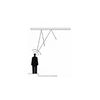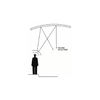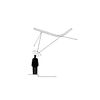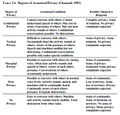atom03:Sound
(→human perception and reaction to sound) |
(→what is sound?) |
||
| (28 intermediate revisions by 3 users not shown) | |||
| Line 1: | Line 1: | ||
=<span style="color:">what is sound?</span>= | =<span style="color:">what is sound?</span>= | ||
| − | Sound is a mechanical wave that is an oscillation of pressure transmitted through a solid, liquid, or gas | + | Sound is a mechanical, longitudinal wave that is an oscillation of pressure (series of compressions and rarefactions) transmitted through a solid, liquid, or gas. |
| − | + | [[atom03: sound glossary|sound terminology]] | |
| − | + | =<span style="color:">sound reflection and space</span>= | |
| − | + | ||
| − | + | <div style="float: left; width: 310px; margin-right:20px; text-align:left"> | |
| − | + | '''Principle of reflection''' | |
| + | [[Image:Reflection.jpg|thumb|right |100px|]] | ||
| + | A reflection wave is yielded when an incidental wave comes to the boundary, and the reflector directs the wave just as light reflector directs light rays. So, in every case, the direction of propagation of the wave is perpendicular to the front, and the reflective wave will be reflected at an equal angle to the incident angle. | ||
| − | ''' | + | '''Flat surfaces''' |
| + | [[Image:Reflection_flat_surface.jpg|thumb|right |100px|]] | ||
| + | A flat surface is effective in distributing sound. If the surface is large enough and positioned correctly, a flat surface can project sound toward the listeners. Flat surfaces can also cause problems if placed incorrectly. For example, a flat, reflective rear wall in an auditorium will reflect sound back toward the speaker, this is called "slap-back". Parallel reflective walls can create a reflection between the two surfaces, this is referred to as "flutter echo" or "standing wave". Two flat surfaces coming together to form a peak can act as a megaphone and amplify the reflected sound. | ||
| − | ''' | + | </div> |
| + | <div style="float: left; width: 310px; margin-right:20px; vertical-align;text-align:left"> | ||
| + | '''Concave surfaces''' | ||
| + | [[Image:Reflection_concave_surface.jpg|thumb|right |100px|]] | ||
| + | Concave surfaces cause reflections to be concentrated rather than dispersed. This causes an abundance of reflection to be heard by the listeners in the focal point, or the point at which all of the reflections are focused. Reflections can also travel along a concave surface bringing delayed reflections around the room. | ||
| − | ''' | + | '''Convex surfaces''' |
| + | [[Image:Reflection_convex_surface.jpg|thumb|right |100px|]] | ||
| + | Convex surfaces are the best surfaces for distributing sound. They provide a wide spread of reflected sound. | ||
| − | |||
| − | |||
| − | |||
| − | |||
| − | |||
| − | |||
| + | </div> | ||
| − | |||
| − | |||
| − | |||
| − | |||
| − | </ | + | <br style="clear: both; height: 0; line-height: 0; font-size: px; /*for IE*/"/> |
| + | =<span style="color:">human perception and reaction to sound</span>= | ||
| + | The human hearing system has an average frequency range of about 20 Hz to 20.000 Hz. This frequency range changes as part of te human ageing process, particularly in terms of the upper limit, this limit tends to reduce. | ||
| + | The hearing system of human has a threshold of hearing and a threshold of pain. These thresholds do mark the boundaries of the hearing system. The threshold of hearing varies with frequency. The ear is far more sensitive in the middle of its frequency than at it's high and low extrem (see picture of the average threshold of hearing and the threshold of pain). | ||
| + | As we can see from the picture the minimum sound level and the maximum sound level which can be detected are respectively 0 and 130 dB. | ||
| + | The perceived loudness of an acoustic sound depends on the function of both frequency and amplitude.(This is also illustrated in the picture which deals about the equal loudness for the human ear). This picture shows the contours of equal loudness for the human ear. The phon scale is a function of frequency and sound pressure levels. | ||
| + | Apart from frequency and amplitude duration also has an effect on the perception of loudness. When a sound lasts more than 200 ms the perceived level does not change. | ||
| − | + | <gallery perrow="6"> | |
| + | File:treshold of hearing and pain.jpg|The average human threshold of hearing and the threshold of pain | ||
| + | File:graph for equal perception of loudness.jpg|Equal loudness for the human ear | ||
| + | File:Acoustical_privacy.jpg|acoustical privacy | ||
| + | File:Db_levels.jpg|sound pressure scenario | ||
| + | File:Human_reaction_to_change_levels.jpg|sensitivity to db. change | ||
| + | </gallery> | ||
| − | =<span style="color:"> | + | =<span style="color:"> sound vs noise</span>= |
| − | + | '''''Sound''''' is a form of energy that is transmitted by pressure variations which the human ear can detect. When one plays a musical instrument, say a guitar, the vibrating chords set air particles into vibration and generate pressure waves in the air. A person nearby may then hear the sound of the guitar when the pressure waves are perceived by the ear. Sound can also travel through other media, such as water or steel.Apart from musical instruments, sound can be produced by many other sources - man's vocal cord, a running engine, a vibrating loudspeaker diaphragm, an operating machine tool, and so on. | |
| − | + | '''''Noise''''' is a combination of different sounds, that cannot be clarified. Usually the sound of a violin is referred to as music - is something pleasing. Depending on other factors, the sound may be perceived as noise.Noise perception is subjective. Factors such as the magnitude, characteristics, duration, and time of occurrence may affect one's subjective impression of the noise. | |
| − | + | ||
| − | + | ||
| − | ''' | + | |
| − | + | ||
| − | ''' | + | |
| − | + | ||
| − | + | ||
| − | + | ||
| − | + | ||
| − | + | ||
| − | + | ||
| − | + | ||
| − | + | ||
| − | + | ||
| − | + | ||
| − | + | ||
| − | + | ||
| − | + | ||
| − | + | ||
| − | + | ||
| − | + | ||
| − | + | ||
| − | + | ||
| − | + | ||
| − | + | ||
| − | + | ||
| − | ''' | + | |
| − | + | ||
| − | ''' | + | |
| − | + | ||
| − | + | ||
| − | + | ||
| − | + | ||
| − | + | ||
| − | + | ||
| − | + | ||
| − | ' | + | |
| − | |||
| − | |||
Latest revision as of 11:25, 17 October 2011
Contents |
what is sound?
Sound is a mechanical, longitudinal wave that is an oscillation of pressure (series of compressions and rarefactions) transmitted through a solid, liquid, or gas.
sound reflection and space
Principle of reflection
A reflection wave is yielded when an incidental wave comes to the boundary, and the reflector directs the wave just as light reflector directs light rays. So, in every case, the direction of propagation of the wave is perpendicular to the front, and the reflective wave will be reflected at an equal angle to the incident angle.
Flat surfaces
A flat surface is effective in distributing sound. If the surface is large enough and positioned correctly, a flat surface can project sound toward the listeners. Flat surfaces can also cause problems if placed incorrectly. For example, a flat, reflective rear wall in an auditorium will reflect sound back toward the speaker, this is called "slap-back". Parallel reflective walls can create a reflection between the two surfaces, this is referred to as "flutter echo" or "standing wave". Two flat surfaces coming together to form a peak can act as a megaphone and amplify the reflected sound.
Concave surfaces
Concave surfaces cause reflections to be concentrated rather than dispersed. This causes an abundance of reflection to be heard by the listeners in the focal point, or the point at which all of the reflections are focused. Reflections can also travel along a concave surface bringing delayed reflections around the room.
Convex surfaces
Convex surfaces are the best surfaces for distributing sound. They provide a wide spread of reflected sound.
human perception and reaction to sound
The human hearing system has an average frequency range of about 20 Hz to 20.000 Hz. This frequency range changes as part of te human ageing process, particularly in terms of the upper limit, this limit tends to reduce. The hearing system of human has a threshold of hearing and a threshold of pain. These thresholds do mark the boundaries of the hearing system. The threshold of hearing varies with frequency. The ear is far more sensitive in the middle of its frequency than at it's high and low extrem (see picture of the average threshold of hearing and the threshold of pain). As we can see from the picture the minimum sound level and the maximum sound level which can be detected are respectively 0 and 130 dB. The perceived loudness of an acoustic sound depends on the function of both frequency and amplitude.(This is also illustrated in the picture which deals about the equal loudness for the human ear). This picture shows the contours of equal loudness for the human ear. The phon scale is a function of frequency and sound pressure levels. Apart from frequency and amplitude duration also has an effect on the perception of loudness. When a sound lasts more than 200 ms the perceived level does not change.
sound vs noise
Sound is a form of energy that is transmitted by pressure variations which the human ear can detect. When one plays a musical instrument, say a guitar, the vibrating chords set air particles into vibration and generate pressure waves in the air. A person nearby may then hear the sound of the guitar when the pressure waves are perceived by the ear. Sound can also travel through other media, such as water or steel.Apart from musical instruments, sound can be produced by many other sources - man's vocal cord, a running engine, a vibrating loudspeaker diaphragm, an operating machine tool, and so on. Noise is a combination of different sounds, that cannot be clarified. Usually the sound of a violin is referred to as music - is something pleasing. Depending on other factors, the sound may be perceived as noise.Noise perception is subjective. Factors such as the magnitude, characteristics, duration, and time of occurrence may affect one's subjective impression of the noise.
sources: environmental protection department - goverment of Hong Kong / Long, Architectural Accoustics. Elsevier Academic Press, London 2006.







